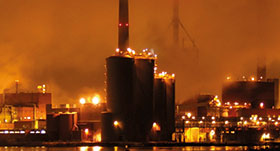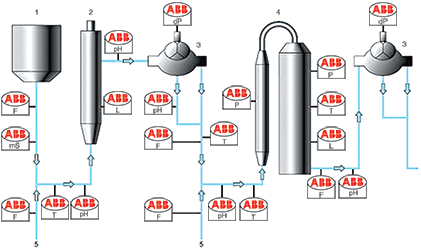

Unbleached pulp has a brown colour due to the remaining lignin of the mechanical pulp. As a result, the pulp requires bleaching to achieve the required quality for producing white paper.
Bleaching is a process that improves the purity and brightness of fibre suspensions using chemicals. Usually, a bleaching plant comprises the reaction container and machines, the piping, the equipment for refilling, storing and conditioning the bleaching chemicals, and the control system for pulp bleaching. A bleaching plant normally comprises several bleaching stages, for economic reasons.
A conventional multi-stage bleaching plant contains several bleaching towers and peroxide stages with downstream washing units. Using multi-stage systems on one hand reduces the expenditure regarding chemicals and heat, but on the other, requires specific bleaching chemicals and processing conditions to achieve some targets (e.g. a high degree of whiteness combined with a low stability loss of the fibres).

Principle of operation
Coloured pulp is conveyed from the digester via the delignification to the first stage of the bleaching system. The pulp reaches the first bleaching tower, where a hydrostatic pressure transmitter (L) and electromagnetic flowmeters (F) provide for constant levels and optimal production rates. Additionally, the chemicals are supplied to the bleaching tower.
Electromagnetic flowmeters (F) are used for dosing control. Pressure transmitters (P), temperature sensors (T) and pH measuring systems (pH) monitor the chemical reactions and reduce both quality variations and the energy cost.
After this, the pulp reaches the washing unit, where a wash filter removes the bleaching products. Conductivity measuring systems (mS) ensure an optimal washing process and provide for constant balancing of the salt content in the process. Filter and sieve monitoring for long-term efficient filtration is realised using differential pressure transmitters (dP).
The process described here repeats in subsequent oxygen and peroxide stages.
ABB offers a comprehensive portfolio for optimal papermaking. Engineered solutions for process measurement advanced systems ensure process efficiency together with state-of-the-art instrumentation.
(F) Electromagnetic flowmeter FSM4000, separated model:
• Suitable for multi-phase liquids.
• High performance due to DSP technology.
• Short response time undisturbed output.
• Local indication of measuring value.
• Integrated monitoring and diagnosis functions.
(T) Temperature sensor TSP121 with integrated head mounted transmitter TTH300:
• Various process connections.
• Optionally with tip for short response time.
• Measuring insert replaceable during operation.
• Various selectable transmitter types.
(P,L) Pressure transmitter 261G:
• Wide range of possible spans.
• Various process connections.
• Optional control and display panel.
• Optimised for harsh process conditions.
(dP) Transmitter for differential pressure 266DS:
• High base accuracy 0.04%.
• Long term stability.
• Wide range of available sensors.
• Various process connections.
(pH) pH/Redox measuring system with transmitter TB82pH and sensor TB557:
• Single-rod measuring cells with wood diaphragm.
• Various electrode models, resistant to deposits.
• Long life cycle, minimum maintenance requirements.
• Robust transmitter with sensor diagnostics.
(mS) Conductivity measuring system with transmitter TB82EC and sensor TB465:
• High pressure and temperature resistance.
• Various optimised designs.
• Robust transmitter with sensor diagnostics.
• High availability and easy operation.
For more information contact ABB South Africa, +27 (0)10 202 5000, instrumentation@za.abb.com, www.abb.com/measurement
| Tel: | +27 10 202 5000 |
| Fax: | +27 11 579 8441 |
| Email: | contact.center@za.abb.com |
| www: | www.abb.com/za |
| Articles: | More information and articles about ABB South Africa |
© Technews Publishing (Pty) Ltd | All Rights Reserved